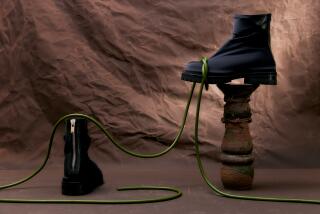Hotels are next step for some fashion houses and luxe brands
- Share via
Looking to step into something new from the fabulous Ferragamo footwear family? How about a hotel?
The Portrait Firenze, owned by Ferragamo’s Lungarno Collection, offers a restrained, elegant series of black-and-white rooms in Florence, Italy, next to the city’s ocher-hued Ponte Vecchio. The 34-suite hotel opened in May, promising “bespoke tourism,” preferential treatment in the stylish shops on the Via Tornabuoni and a warm welcome at the Museo Salvatore Ferragamo, just a few blocks away. Introductory rates start at about $625 a night.
The Portrait Firenze is just the latest of several Italian lodgings opened by the family, a phenomenon that has been embraced by many other luxury brands and fashion houses. There’s a Bulgari hotel coming soon in Shanghai; a Tommy Hilfiger-owned property in Miami Beach; and a Versace Palazzo due soon in Dubai.
Armani, meanwhile, has hotels in Dubai and Milan, Italy (minimalist, of course, with lots of black and beige). And Moschino is renting rooms in Milan as well: Behind the neoclassical façade of an 1840 train station, Maison Moschino, which opened in 2010, has 65 rooms filled with playful imagery and surreal flourishes.
“This is an emerging niche,” said hotel analyst Henry Harteveldt of Atmosphere Research Group, noting that these ventures allow brands to present themselves in a new dimension and “allow consumers to ‘live’ the brand vision.”
Upscale hotels through the years often have invited fashion designers or luxury brands to work a little magic here and there. But when a fashion house or luxury brand buys its own hotel or puts a designer’s name above the door in foot-high letters, the stakes are higher.
This trend seems to align with new thinking about the habits of consumers born since 1980. Many social theorists and marketing consultants, including pollster John Zogby and entrepreneur Graham Hill (founder of two lifestyle-simplification websites), said these millennials often get more excited about racking up experiences than accumulating possessions.
Status symbolism is evolving, and “your reputation is more digital,” said Hill, citing Facebook and Instagram. “You used to show off your car or your house. Now,” he said, “social currency is built less from owning that cool car and more from the experiences that you have and are able to share.” And who knows? After a few nights at an exclusive island resort, you might acquire some branded merchandise.
The house of Versace (whose late founder, Gianni Versace, presented his first fashion collection in 1978) said it created “the world’s first fashion-branded hotel” in 2000 when it opened the Palazzo Versace on Australia’s Gold Coast, south of Brisbane. Inspired by “opulent palaces of Europe and the classical architecture of Roman times,” its rooms are filled with richly textured fabrics in gold and fuchsia, parquet floors and Italian marble in the bathrooms. It has a spa, a marina, a 1,650-pound foyer chandelier from Milan and, of course, a Versace boutique.
This year, the company is due to open another Palazzo on the Dubai waterfront (with more golden hues, marble and parquetry). Yet another is due in 2017 on Macau as part of a $3.9-billion Lisboa Palace casino resort complex. In artists’ renderings, that complex looks like an 18th century French chateau with Chinese overtones.
It seems there are as many ways to enter the hospitality trade as there are ways to drape a midriff.
In Miami Beach, Hilfiger has bought the Raleigh Hotel, a 1940 Art Deco landmark. After the purchase, in March, Hilfiger said he would use the 105-room hotel to launch and define his hospitality brand, with renovations starting in January. But Hilfiger, known for his preppy sensibility, hasn’t made any fast moves. Three months after the deal, his name was absent from the Raleigh’s website, and the hotel’s previous owner, SBE Entertainment Group, was still managing the property.
In Shanghai, a new Bulgari Hotel is due to open in 2015, occupying the top 12 floors of a 40-story skyscraper in the city’s historic Zhabei District, juxtaposing ancient and modern architectural themes. If the advance images are representative, the rooftop terrace will offer jaw-dropping views of that city’s ever-soaring skyline.
The Shanghai Bulgari follows on the heels of the London Bulgari Hotel (2012) and others in Milan (2004) and Bali (2006), all designed to deliver “an Italian contemporary luxury feel” in harmony with the local culture. (Bulgari representatives said the floral and foliate patterns in the London Bulgari’s rooms were inspired by a brooch made by Sotirio Bulgari in the 19th century.) Another Bulgari is planned for Dubai in 2018.
These moves harmonize well with the approach of LVMH, the luxury conglomerate that bought most of Bulgari in 2011.
LVMH, which also owns Louis Vuitton, Moët & Chandon, TAG Heuer and other luxury brands, has been adding hotels for several years, often under the Cheval Blanc banner.
In the Maldives, LVMH’s Cheval Blanc Randheli island resort opened in November 2013 — a sleek, bright haven of 45 palm-shaded seaside villas, thatched roofs, white walls, yellow accents and reflecting pools on an atoll known as Noonu. Guests are served by a major-domo and “alchemists” who help with unpacking and arrange sandbar barbecues and visits to the manta ray nursery. One-bedroom villas routinely cost $1,300 per night. Guests arrive by De Havilland seaplane, and the shop offers special Hublot diver’s watches, available only on-site.
In the French West Indies, LVMH has bought the Hotel Saint-Barth Isle de France, which on Oct. 15 becomes the Cheval Blanc St. Barth Isle de France. Lushly planted and full of nautically influenced woodwork and furnishings, this hotel features a palette that combines Cheval Blanc’s signature taupe with blush pink. It has 40 rooms, suites and villas, a restaurant, a spa and the Concept Store shop, which promises creations from local designers and international brands, with poolside fashion shows on Tuesday nights.
Closer to LVMH’s Paris headquarters, a new flagship Hotel Cheval Blanc (designed by French architect Edouard Francois) is a central element in the redevelopment of the Samaritaine department store, a First Arrondissement landmark (part art nouveau, part Art Deco) that’s been closed since 2005. The hotel will have 72 rooms and overlook the Seine. The opening was set for 2016, but preservationists have mounted a legal challenge that has delayed work.
LVMH first waded into the hotel trade with the Cheval Blanc Courchevel, a 36-unit ski-in hotel that opened in 2006 in the French Alps. Other hotel projects include the 2012 opening of White 1921 in Saint-Tropez (eight rooms, $380-$1,350). These are projects that don’t necessarily share a design aesthetic, but they do radiate luxury and exclusivity.
“A hotel experience is immersive,” said Chip Conley, who founded the Joie de Vivre boutique hotel chain and now serves as head of global hospitality and strategy for Airbnb. “You sleep with the product, you eat with the product, you get naked with the product. And what all retailers are looking for is how to create a deeper connection with [their] customers.”
Status symbolism is becoming less about things and more about experiences.
More to Read
Sign up for The Wild
We’ll help you find the best places to hike, bike and run, as well as the perfect silent spots for meditation and yoga.
You may occasionally receive promotional content from the Los Angeles Times.







